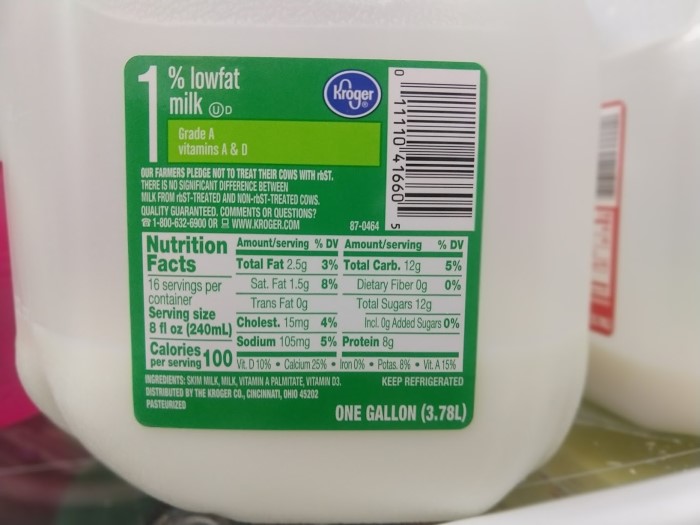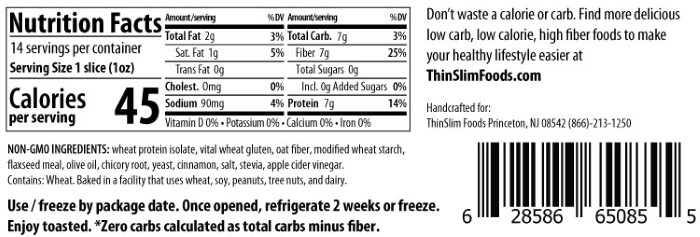The Rules for Calorie Content on Nutrition Labels - And Why You'll Never See 107 Calories Per Serving
This site utilizes Google Analytics, Google AdSense, as well as participates in affiliate partnerships with various companies including Amazon. Please view the privacy policy for more details.
Have you ever read the back of the cereal box while eating breakfast? Checked out the nutrition label? Read the ingredient list?
Or maybe you’re someone who knows the ins-and-outs of the nutrition label. You always read the ingredients, and keep track of your food in an app such as MyFitnessPal.
If you have, maybe you’ve noticed that you’ve never seen a nutrition label with an odd number of calories. You’ll never see something with 107 calories per serving - it’s always going to be something like 100 or 110 calories per serving.
And exactly how are the number of calories determined? Is there some lab that food is sent to, and then someone eats it, to determine how many calories it has?
It turns out the rules for nutrition labeling of food are spelling out in Title 21, Chapter I, section 101.9 of the United States Code of Federal Regulations.
The Code of Federal Regulations is a lengthy, 50-title, with each title having multiple chapters and subchapters, that detail the regulations for everything from agriculture to transportation. If you want to read all 50 titles, they’re available at the eCFR site (eCFR meaning “electronic Code of Federal Elections”).
The Rules for Rounding Calories
The reason that you’ll never see something with 107 calories per serving is that calories are rounded to zero if there are less than five calories, to the nearest 5-calorie increment there are less than 50 calories, and to the nearest 10-calorie increment there are more than 50 calories.
The rules are cryptically spelled out in paragraph (c)(1):
(c)(1) “Calories, total,” “Total calories,” or “Calories”: A statement of the caloric content per serving, expressed to the nearest 5-calorie increment up to and including 50 calories, and 10-calorie increment above 50 calories, except that amounts less than 5 calories may be expressed as zero. Energy content per serving may also be expressed in kilojoule units, added in parentheses immediately following the statement of the caloric content.
Tic Tacs infamously use the “amounts less than 5 calories may be expressed as zero” rule, although sometimes they do label themselves as having one calorie.
The Rules for Determining Calories
Now that we know the rules for rounding calories - what are the rules for determining calories? Why does some food have 50 calories, and another 100?
The CFR allows six different ways to determine caloric content, spelled out in paragraphs (c)(1)(A) through (c)(1)(F):
(A) Using specific Atwater factors (i.e., the Atwater method) given in table 13, USDA Handbook No. 74 (slightly revised, 1973),
(B) Using the general factors of 4, 4, and 9 calories per gram for protein, total carbohydrate, and total fat, respectively, as described in USDA Handbook No. 74 (slightly revised, 1973) pp. 9-11;
(C) Using the general factors of 4, 4, and 9 calories per gram for protein, total carbohydrate (less the amount of non-digestible carbohydrates and sugar alcohols), and total fat, respectively, as described in USDA Handbook No. 74 (slightly revised, 1973) pp. 9-11. A general factor of 2 calories per gram for soluble non-digestible carbohydrates shall be used. The general factors for caloric value of sugar alcohols provided in paragraph (c)(1)(i)(F) of this section shall be used;
(D) Using data for specific food factors for particular foods or ingredients approved by the Food and Drug Administration (FDA) and provided in parts 172 or 184 of this chapter, or by other means, as appropriate;
(E) Using bomb calorimetry data subtracting 1.25 calories per gram protein to correct for incomplete digestibility, as described in USDA Handbook No. 74 (slightly revised, 1973) p. 10; or
(F) Using the following general factors for caloric value of sugar alcohols: Isomalt - 2.0 calories per gram, lactitol - 2.0 calories per gram, xylitol - 2.4 calories per gram, maltitol - 2.1 calories per gram, sorbitol - 2.6 calories per gram, hydrogenated starch hydrolysates - 3.0 calories per gram, mannitol - 1.6 calories per gram, and erythritol - 0 calories per gram.
I don’t blame you if you skipped over those and came right to this sentence; those six paragraphs are awfully dense and hard to read.
I’ve found that most of the nutrition labels I’ve looked at use the method from paragraph (c)(1)(B) - 4 calories for every gram of protein and carbohydrate, and 9 calories for every gram of fat.
Examples
One Percent Lowfat Milk

The nutrition label for one percent lowfat milk.
The above nutrition label for one percent lowfat milk says that one serving of the milk has 2.5 grams of fat, 12 grams of carbohydrates (“carbs”), and 8 grams of protein.
When we use the rule of 4 calories for every gram of protein and carbohydrate, and 9 calories for every gram of fat, we end up with the following for each of these nutrients:
2.5 × 9 = 22.5 calories
12 × 4 = 48 calories
8 × 4 = 32 calories
Sum these three calorie amounts and we get:
22.5 + 48 + 32 = 102.5 calories
Since 102.5 calories is greater than 50, we round to the near 10 calories - which happens to be 100 calories. And 100 calories just so happens to be the calories listed on the nutrition label!
Whole Grain Oatmeal

The nutrition label for whole grain oatmeal.
The above nutrition label for whole grain oatmeal says that one serving of the milk has 2.5 grams of fat, 27 grams of carbohydrates, and 5 grams of protein.
When we use the rule of 4 calories for every gram of protein and carbohydrate, and 9 calories for every gram of fat, we end up with the following for each of these nutrients:
2.5 × 9 = 22.5 calories
27 × 4 = 108 calories
5 × 4 = 20 calories
Sum these three calorie amounts and we get:
22.5 + 108 + 20 = 150.5 calories
Since 150.5 calories is greater than 50, we round to the near 10 calories - which happens to be 150 calories. And 150 calories just so happens to be the calories listed on the nutrition label!
The Exception to the Rule: Net Carbs and Low Carb Bread
The only food I’ve come across so far that doesn’t use the 4-9-4 method (that is, 4 calories per gram of protein and carbohydrate, and 9 calories per gram of fat) is “low carb” bread.
Check out this nutrition label for Thin Slim Foods Zero Net Carb Bread:

The nutrition label for zero net carb bread.
The label says it has 2 grams of fat, 7 grams of carbs, and 7 grams of protein. Using the method we used on the milk and oatmeal, we get:
2 × 9 = 18 calories
7 × 4 = 28 calories
7 × 4 = 28 calories
18 + 28 + 28 = 74 calories
No amount of rounding is going to get the 74 calories down to the 45 calories listed on the label. So what’s going on?
It turns out the label is calculating the carbs as “net carbs” - which is the difference between the total carbs and the fiber. Since there is both 7 grams of carbs, and 7 grams of fiber, the “net carbs” is zero (as advertised!). Redoing our math with zero carbs, we get:
2 × 9 = 18 calories
0 × 4 = 0 calories
7 × 4 = 28 calories
18 + 0 + 28 = 46 calories
Since 46 is less than 50, we round to the nearest 5 calories - which is 45 calories, exactly what the label reads.
Are they breaking any rules by doing this? Remember that the 4-9-4 method was just one of six permitted methods to determine caloric content. There’s no rule that says how a labeler chooses which method, so they’re free to use a method that they might find more advantageous.
Additional Sources
Leave a Reply
